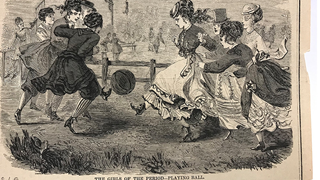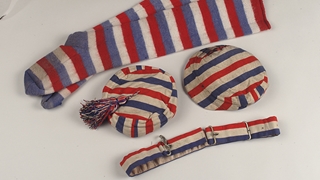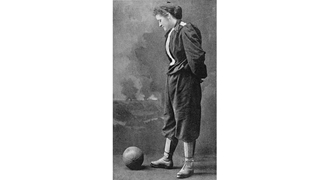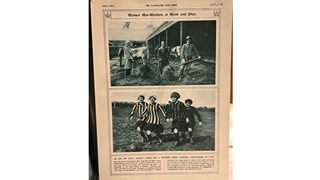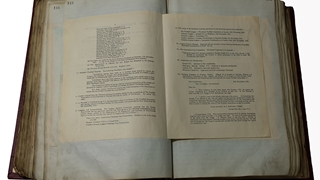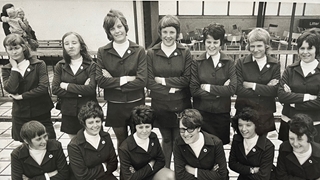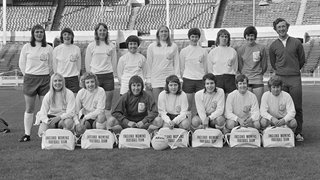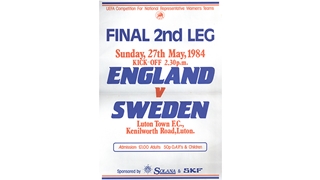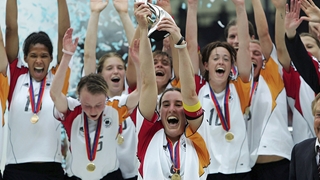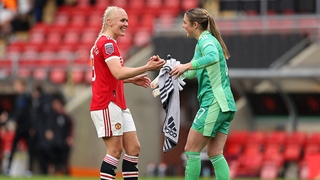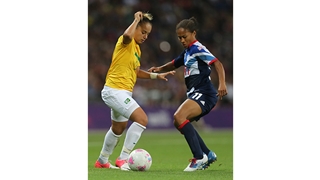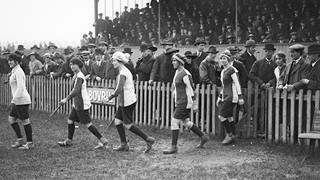
EARLY YEARS
Although the game of football has been played for centuries – for example, Shakespeare mentions it in two of his plays: The Comedy of Errors (1594) and King Lear (1608) – you might think that women have only been playing over the last generation or so. In fact, their participation dates back much further than you might imagine. It is claimed that Mary Queen of Scots herself owned the oldest football in existence. Sir Philip Sidney’s poem A Dialogue Between Two Shepherds, written in 1580, refers to women playing:
‘A tyme there is for all, my mother often sayes,
When she, with skirts tuckt very hy, with girles at football playes.’
Football remained a popular pastime, but it took another 300 years for the game to be codified into a standard set of rules by the newly formed Football Association in 1863. These rules were partly intended to stop on-pitch violence and make it more acceptable for women to play.
The first recorded women’s football match was on 7 May 1881, when a supposed ‘Scotland’ women’s team played ‘England’ at Easter Road, Edinburgh. In actual fact the birthplace and therefore nationalities of the players has been called into question and it’s believed at least some of the players were from the theatre community ‘acting’ out these team roles.
The two teams played several matches, but two – in Glasgow and Manchester – were abandoned due to pitch invasions. In Glasgow the players had to escape in a horse-drawn bus! In the first match – which wasn’t abandoned – Lily St Clair netted the first goal in front of a crowd of about 2,000 and in doing so became the first recorded female goal scorer in the history of the game. The team representing Scotland were 2-0 winners.
Image courtesy of the National Football Museum
As the 1890s unfolded, so women’s club football gained momentum. Local clubs competed against each other in matches and competitions. Madam Kenney’s Famous Edinburgh Team beat Grimsby Town Ladies 1-0 on 23 April 1887 at the Thornes football field in Wakefield. Some teams were formed by women working in factories. On 2 February 1899, a six-a-side game saw Greener’s Violets win by 8-2 over Greener’s Cutters. Both teams worked at the same glassworks in Sunderland. There are also records of clubs at this time in Grimsby and Preston.
In London, the British Ladies’ Football Club (BLFC) was formed in 1895 by Alfred Hewitt Smith, with Nettie J. Honeyball (thought to be a pseudonym) as captain. President of the BLFC was Lady Florence Dixie, a renowned Scottish writer, adventurer, war correspondent and feminist. Dixie insisted players wore practical clothes, including bloomers, shinpads and proper boots, so they would be free to run around.
The BLFC staged a North v. South of The Thames clash on 23 March 1895. 10,000+ paying spectators crammed into the Crouch End Athletic ground to watch the 60-minute match. The North won 7-1, but the profile and attendance of the game made a wider point. BLFC attracted attention to the growing women’s rights movement. Campaigns such as Votes for Women (1897) and the formation of the National Union of Women’s Suffrage Societies and in 1903, The Women’s Social and Political Union highlighted women’s growing calls for emancipation. The calls were getting ever louder. Ultimately, they were irresistible.
Image courtesy of the National Football Museum
THE GAME GROWS
During World War One, women increasingly took on traditionally male jobs, particularly and typically working in factories. Sporting activity within these often dark and dirty factories was encouraged to benefit health and wellbeing, as well as to help aid morale and productivity. Football was a natural outlet for this and many factories developed their own teams. In 1917 the munitions factories gave birth to the Munitionettes’ Cup, with Blyth Spartans Munitionettes beating Bolckow, Vaughan & Co 5-0 in the final.
By far the most famous and one of the most successful of the factory-based teams of the time was Dick, Kerr & Co. From 1917 right through to 1965 they played 800 games - winning 746! They also produced the country’s best-ever goal scorer, Lily Parr, who is believed to have scored around 900 goals during her 30-year career. During and after the War, Dick, Kerr Ladies toured the country playing charity games to raise money for injured servicemen. Arguably, they were the first ‘professional’ women’s side and players were paid 10 shillings (50p) to cover their expenses.
Image courtesy of the National Football Museum
By 1921 there were about 150 women’s football clubs. Matches were popular spectator events and some drew up to 45,000 fans. The future of the women’s game looked bright.
Despite its growing popularity and the re-emergence of international matches after World War One, controversy was just around the corner. Many factories closed and women went back into domestic life or retrained in professions such as bus conductors and nurses. At the same time, some people questioned whether football was damaging women’s health. Dr Mary Scharlieb of Harley Street for example described it as the “most unsuitable game, too much for a women’s physical frame”.
Image courtesy of the National Football Museum
BANNED
On 5 December 1921, the FA met at its headquarters in London and announced a ban on the women’s game from being played at the professional grounds and pitches of clubs affiliated to the FA, stating “the game of football is quite unsuitable for females and ought not to be encouraged.”
The ban meant the women’s game was side-lined to being played in public parks for nearly 50 years.
Despite this, women were determined to keep playing football and around 30 teams from across England met in Liverpool on 10 December 1921 to formalise the English Ladies Football Association (ELFA). This aimed “to popularise the game among girls and to assist charity".
The following year saw the first and only ELFA Challenge Cup competition. Stoke Ladies lifted the trophy, beating Doncaster and Bentley Ladies 3-1 in the June 1922 final.
Though stymied by a lack of decent-sized facilities, women’s football carried on throughout the ‘30s, ‘40s, ‘50s and most of the 1960s. Games were played at rugby venues and smaller grounds which couldn’t house many fans. Though the women continued to play, they became increasingly overshadowed by the men’s game. In 1947, Kent County Football Association suspended a referee because he was also working as manager of the Kent Ladies Football Club. It justified its decision saying that "women's football brings the game into disrepute".
Image courtesy of the National Football Museum
But clubs continued to start up, a notable example is Manchester Corinthians Ladies FC founded in 1949. Percy Ashley, a scout for Bolton Wanderers, founded the club so his daughter Doris, a talented footballer, could play in a team. The Corinthians played at Fog Lane Park in Didsbury, a suburb south of the city. Players often had to clean themselves in the local duck pond after matches as there was no running water in the changing rooms. The team were very successful, winning many domestic trophies within their first two years. As there were very few local women’s teams, Ashley set up a second team, The Nomads, in 1957 so they could play against the Corinthians in charity matches.
The Corinthians went on to win an unofficial European club championship in Germany in 1957. The team was accompanied by Manchester City’s German goalkeeper, Bert Trautmann, who acted as their interpreter. More overseas trips followed, including to Portugal/Madeira, the Netherlands, South America and the Caribbean, and Morocco. The team won more than 50 trophies and raised £275,000 for charity.
REVIVAL
As society began to change during the 1960s, women started to campaign more for their social rights. On 1 November 1969, representatives of 44 clubs attended the first meeting of the Women’s Football Association (WFA) in London. Arthur Hobbs, a carpenter and amateur footballer, was the first Honorary Secretary of The WFA and Pat Dunn was its first Chair. In 1967, Hobbs had organised a women’s tournament in Deal, Kent, with the support of local miners from Betteshanger Colliery. The Deal Tournament, played on the Colliery’s playing fields, showcased and celebrated women’s football. It was a pre-cursor to the Women’s FA Cup, which would go on to be first played in 1971.
In 1972, Hobbs stepped down as Honorary Secretary due to ill health. He was succeeded by Patricia Gregory, who had been instrumental in setting up the WFA. Gregory founded and played for White Ribbon, a team in London who participated in the Deal Tournament. She went on to have a long career in football administration, serving as a member of the UEFA Women’s Football Committee from 1980 – 1994.
The FA were coming under increasing pressure to lift the ban on women's football. In December 1969, the FA's Executive Committee recommended that what they termed ‘ladies' football" should no longer be classified as unaffiliated. In the following month, at a meeting of the FA Council on 19 January 1970, the FA finally voted to rescind the controversial resolution of 1921 that had banned women's football for being "unsuitable".
But it took a lot more deliberations, crucially including a meeting of the FA's Rules Revision Committee in August, to prepare the way for an amendment to be made to the relevant FA rule. This couldn't be made until the FA's next Annual General Meeting, which was held at the Great Western Royal Hotel in Paddington on 24 June 1971. Women's football could now be played on FA-affiliated grounds and registered referees could officiate at women's matches.
In addition to official league matches, came the launch of a women’s club knock-out competition, later to become the Women’s FA Cup. In 1971 Southampton won the first final and they would go on to lift the trophy eight times in its first eleven years. In 1971, UEFA recommended that the women’s game should be governed by national associations – then numbering 32 – across Europe. The FA made their announcement on recognising The Women’s FA (WFA) on 29 February 1972.
In November of the same year – 1972 – the first official WFA England team travelled to Scotland for an international match in which England came from behind to win 3-2 with goals from Sylvia Gore, Lynda Hale and Jeannie Allott. That 2-0 defeat between two unofficial sides some 91 years earlier had finally been avenged. The match itself came exactly 100 years after the first recognised men's international, also played between Scotland and England. At this time opportunities for women to represent England in international competitions were still scarce. Between 1972 and 1978, there were only 25 international matches played.
Now the push was on to integrate women’s football into the fabric of our national sport. That push continued to be led by the WFA. In 1981 they opened their own administrative office although the sport continued to be largely run through the dedication of volunteers. The WFA grew the women’s game throughout the 1970s, ‘80s and early ‘90s.
The FA however was beginning to take a keener interest and in May 1984 the WFA was affiliated with the same status as County FAs. This opened the doors to more central FA support, but much more still needed to be done. That same year, 1984, saw England lose to Sweden – 4-3 on penalties – in the two-legged final of the first UEFA competition for national representative women's teams. This was the predecessor to the Women’s EUROs.
Image courtesy of the National Football Museum
A DECADE OF FIRSTS
The 1990s saw the first strategic plans to develop the women’s game in England, together with the first 20 Centres of Excellence for girls and also, in 1998, the first full-time England women’s coach, Hope Powell – later to be honoured with both an OBE and CBE.
1991 saw another key moment when the WFA launched a 24-club national league which the following year was expanded to three divisions of ten teams (Premier, Division 1 North and Division 1 South). Further fundamental change happened two years later, in 1993, as the WFA voted to pass over its activities to the FA. It no longer had the financial resources to develop the game it had nurtured. The FA established a Women’s Football Committee and with it the full-time post of Women’s Football Co-ordinator.
The 1993-94 season also saw the WFA Cup brought under the control of the FA - 137 teams entered. A year later and the WFA’s national league and league cup were also managed by The FA. This saw the birth of the Women's Premier League (FAWPL).
FIFA introduced the women’s World Cup competition in 1991 and as the women’s game started to grow globally, the decade culminated in the finals in the USA in 1999 that featured sold-out stadia and a 90,000 crowd at the final.
The game was gaining media attention by the day and more importantly, more participants. By 2002 in England, it had become the top participation team sport for women and girls. This FA target was achieved three years ahead of target. In the same year, Lily Parr of Dick, Kerr Ladies became the first woman inducted into the National Football Museum Hall of Fame. This was in part the game acknowledging its roots, but also building its future foundations.
These foundations were given a further boost in 2005 when England hosted the UEFA Women’s EURO. Records for crowd attendance and TV audiences were smashed. England beat Finland 2-1 in front of a then European record crowd of 29,092 at the City of Manchester Stadium. Crucially, the talent pool was getting deeper - there were now England teams at various age groups and the senior team – the Lionesses – were beginning to show their talents on the world stage. The 2000s ended with the senior team winning the Cyprus Cup which was their first international trophy and later in the same year, reaching the final of UEFA Women’s EURO 2009, albeit losing out to Germany who were the dominant force at the time. The WU19s however won their UEFA Championship in Belarus.
The London 2012 Olympic Games gave women’s football in this country a further boost, when the Team GB Women reached the quarter-finals of their competition. Significantly, a 1-0 win over Brazil in Team GB’s third group match was played in front of 70,584 fans at Wembley Stadium. This contrasted markedly with the very first England women's international match played at Wembley only 23 years beforehand (England vs Sweden on 23 May 1989) which took place as a ‘warm up’ before a men's international kick off.
As England’s international teams were getting ever stronger, club football re-formed itself and 2011 saw the inception of The FA Women’s Super League (WSL) which was initially an eight-team summer competition. This replaced the FA Women's Premier League National Division as the highest level of women's football in England and ran on this basis until 2017 when it finally grew into the two-division fully professional game we know today, taking its place alongside the traditional men’s professional season, with media interest, spectator levels and sponsorship income having established a solid commercial platform. The top three teams each season qualify for the UEFA Women’s Champions League. The WSL has increased the visibility of women’s club football across the world, attracting star players from overseas and broadcast partners in Australia, Canada, Dominican Republic, Mexico, Germany, Italy, Scandinavia, New Zealand and the US. Below the two professional divisions, the game’s pyramid – the Women’s National League – has continued to develop. It now means there are recognised pathways into the women’s professional game, with clubs themselves operating Academy structures.
In 2024, the Barclays WSL and the second tier Barclays Women's Championship, migrated to become independent of the FA, with the introduction of Women's Professional Leagues Limited with the aim of spearheading a new era in the sport, dedicated to driving growth and maximising potential, placing players and fans at its core.
NEW ERA
The last 15 years have seen some major developments for both women and girls.
In 2013, the FA, Sport England, the Premier League and the Football League Trust launched their first joint national participation programme for girls’ football.
In 2014, England Women played their first match at the new Wembley Stadium, attracting a then record crowd of 45,619 for their match against Germany. The senior team was by now a serious contender on both European and world stages. They took bronze in the 2015 FIFA Women’s World Cup in Canada and reached the semi-finals of UEFA Women’s 2017 EURO and got to the same stage again in the FIFA Women’s World Cup two years later in France 2019. Their semi-final defeat to the USA attracted a record 11.7m viewers on BBC One.
Earlier in the same year they won the SheBelieves Cup for the first time. This success saw ever-increasing crowds at England matches, with 77,786 fans at Wembley to see the senior team face Germany in November 2019. It is little wonder then that Barclays wanted to secure its place as the title partner of The FA WSL in what is believed to be the biggest-ever investment in UK women’s sport by a brand.
Double participation, double the fanbase and consistent success on the world stage. Those were the three bold goals in The Gameplan for Growth, The FA’s first formal strategy for women’s and girls’ football in England, unveiled in March 2017. All three goals were scored – with more than one million girls (aged 5-15) and 1.9 million women (16+) playing the game in England by the end of the strategy. Numerous FA participation programmes brought girls to football at various age groups and the fan base continued to grow.
Following the first three-year strategy, a new one – Inspiring Positive Change – was launched in October 2020. Among its eight goals, one stands out – to give every school-going girl the same access to football as boys, whether at school or in clubs. This was followed by Reaching Higher - a new women’s and girls’ game strategy for 2024-2028.
A home win in Wembley for England at the UEFA Women’s EURO 2022 in front of a crowd of 87,192 has firmly established the women’s game in the national psyche.
Media coverage and general interest in the game has never been higher. As well as huge success on the field, the game-changing tournament created over 400,000 new opportunities for girls and women to engage in grassroots legacy football activities. The win was the glorious icing on the cake of a decade of growth and investment. It was a wonderful serendipity that the win came in the 50th anniversary year of England Women; a moment we all got to celebrate at Wembley on 7 October 2022 when Jill Scott presented the original 1972 team with their long-awaited caps.
A year later, the Lionesses made more history in Australia when they reached the FIFA Women's World Cup Final in Sydney, a first-ever appearance at that stage of the competition following an exciting campaign 'down under'. Unfortunately, Sarina Wiegman's team came up against a Spanish team who had swept all before them in the competition and lost by 1-0 in the Final.
However, that disappointment was replaced with further celebrations when the Lionesses retained their UEFA Women's EURO crown at the 2025 tournament in Switzerland with a penalty shootout victory over Spain in the final to become the first England team to win a major title on foreign soil.


